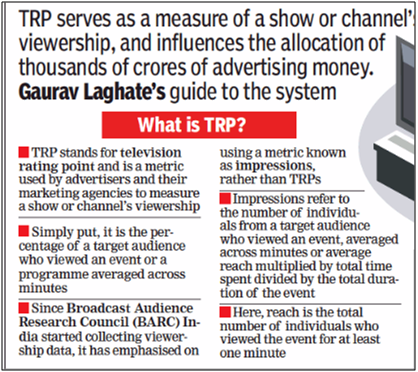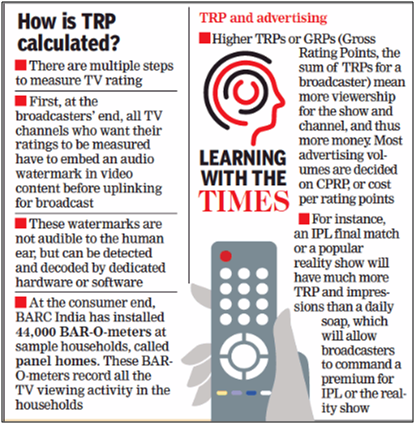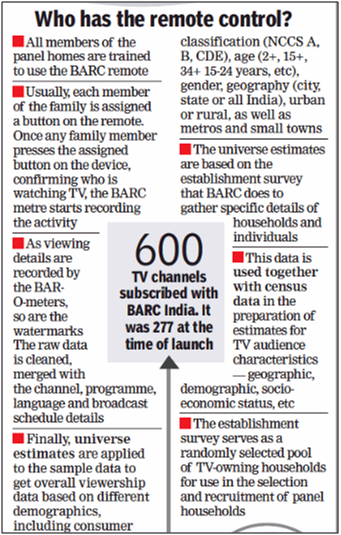How the TRP system works
In News:
- The Mumbai police has launched an investigation into the alleged manipulation of TRPs (Television Rating Points) by some private news channels.
- The police said they learnt that this was done by rigging the devices used by the Broadcast Audience Research Council (BARC) India, which has the mandate to measure television audience in India.
In Focus: TRPs (Television Rating Points)
- In simple terms, TRPs represent how many people, from which socio-economic categories, watched which channels for how much time during a particular period.
- This period measured could be for an hour, a day, or even a week. Importantly, India follows the international standard of one minute.
- The data is usually made public every week.
- On the basis of this audience measurement data, ratings are assigned to various programmes on television.
- TRPs for Indian channels are currently measured by Broadcast Audience Research Council (BARC) India.
Importance:
- Help channels take decisions on various TV programmes:
- Television ratings in turn influence programmes produced for the viewers. Better ratings would promote a programme while poor ratings will discourage a programme.
- However, incorrect ratings will lead to production of programmes which may not be really popular while good programmes may be left out.
- Advertisement revenues for channels:
- TRPs are used by the advertisers to decide which channel to advertise on by calculating the cost-per-rating-point (CPRP).
- As per a FICCI-EY report on India’s media and entertainment industry, the size of the TV industry was Rs 78,700 crore in 2019.
Measurement:
- BARC has installed “BAR-O-meters” in over 45,000 empanelled households, chosen in such a way that they are representative of the country’s population.
- These households are classified into 12 categories under the New Consumer Classification System (NCCS), also referred to as the “new SEC”, adopted by BARC in 2015.
- The categories based on the education level of the main wage earner and the ownership of consumer durables.
- While watching a show, members of the household register their presence by pressing their viewer ID button — every person in household has a separate ID.
- This allows the device to capture the duration for which the channel was watched and by whom, thus providing data on viewership habits across age and socio-economic groups.
About: Broadcast Audience Research Council (BARC)
- BARC is an industry body jointly owned by advertisers, ad agencies, and broadcasting companies, represented by The Indian Society of Advertisers, the Indian Broadcasting Foundation and the Advertising Agencies Association of India.
- Though it was created in 2010, the I&B Ministry notified the Policy Guidelines for Television Rating Agencies in India in January, 2014 and registered BARC in July 2015 under these guidelines, to carry out television ratings in India.
How can TRP data be rigged:
- TRPs are calculated based on what the 45,000-odd empanelled households watch. To rig TRPs, broadcasters can potentially target these households to fudge actual viewership data.
- Since the overall panel size (empanelled housholds) is small, infiltration has a significant impact. In categories like English TV news, where viewership is much smaller, rigging even a few heavy viewing homes can bias the TRPs big time.
- If broadcasters can find the households where BAR-O-meter devices are installed, they can either bribe them to watch their channels, or ask cable operators to ensure their channel is available as the “landing page” when the TV is switched on.
- A big challenge in preventing this is that there is no specific legal framework through which the agents/ suspects involved in panel tampering/infiltration could be penalised. Thus, earlier BARC's efforts in this regard have failed.
Efforts at improve ratings measurement:
- For many years, questions have been raised about ratings by people from within the industry.
- Industry leaders have complained that ratings are not in correlation to the basics of television and that manipulated data is being released.
- Couple of year ago, the I&B Ministry had raised concerns that BARC was under-reporting viewership of Doordarshan, and floated the idea of chip-based activity logs through all set-top boxes. However, the idea was rejected.
Economics




